Discover whether a crib mattress can a crib mattress fit in a pack n play? with our comprehensive guide. Find out the differences between the two and learn practical tips to help you make an informed decision. Read now to ensure your baby’s safety and comfort while sleeping.”
Introduction
Quick Links
As a parent, you are always concerned about your child’s well-being, and ensuring that he or she sleeps comfortably and safely is a top priority. A pack-n-play is a popular choice for parents since it provides a portable and convenient space for infants and young children to sleep. If you have an older child who has outgrown the mattress in the pack-n-play, you may wonder if a crib mattress can be used in the pack-n-play.
We will examine the dimensions of pack-n-play and crib mattresses, factors to consider when determining whether a crib mattress can fit in a pack-n-play, safety concerns, and tips for making a crib mattress fit in a pack-n-play in this article.
After reading this article, you will have the knowledge necessary to determine whether a crib mattress can fit in a pack-n-play and which options are most appropriate for your child’s sleeping requirements.
Differences Between a Pack-n-Play Mattress And a Crib Mattress
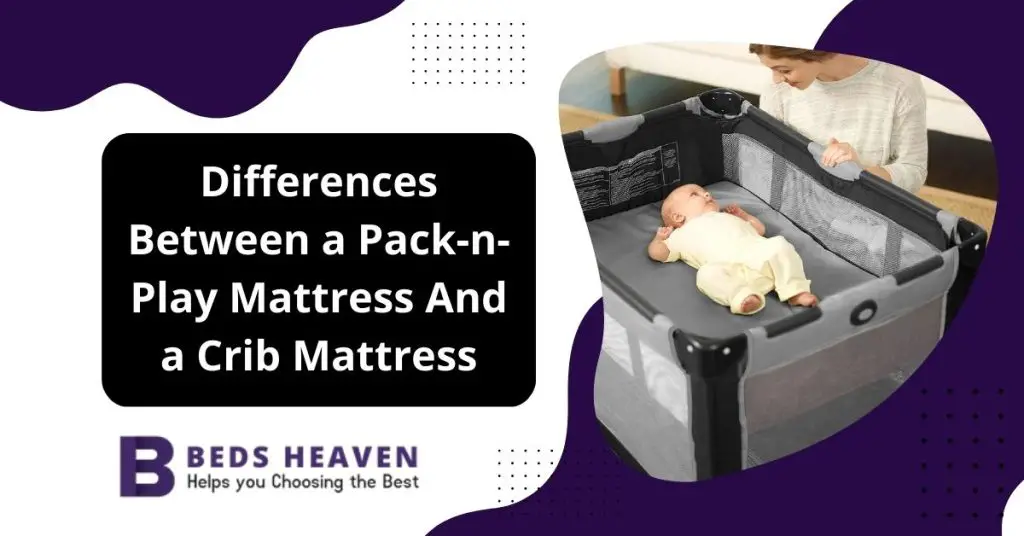
Before attempting to fit a crib mattress in a pack-n-play, you should consider several differences between a pack-n-play mattress and a crib mattress. The following are some of the main differences between the two:
1. Size:
A pack-n-play mattress is typically smaller than a crib mattress. Standard pack n’ play mattresses measure approximately 38 inches long by 26 inches wide, while standard crib mattresses measuring approximately 52 inches long by 28 inches wide.
2. Thickness:
In general, pack-n-play mattresses are thinner than crib mattresses, with an average thickness of one to two inches. As opposed to crib mattresses, which have an average thickness of 5-6 inches, crib mattresses are thicker.
3. Shape:
A pack-n-play mattress is generally rectangular in shape, while a crib mattress is more oval in shape.
4. Material:
A pack-n-play mattress is usually made from foam, while a crib mattress can be constructed from foam, innerspring, or organic materials such as latex or wool.
5. Firmness:
A pack-n-play mattress is usually firmer than a crib mattress in order to ensure the safety of the baby and prevent suffocation. A crib mattress should provide a balance between comfort and support.
It is important to note that pack-n-play mattresses are designed specifically for the use of pack-and-plays and have been thoroughly tested for safety and durability. Your child’s safety and stability may be compromised if you attempt to fit a crib mattress in a pack-n-play.
Common Dimensions Of Pack n Play And Crib Mattresses
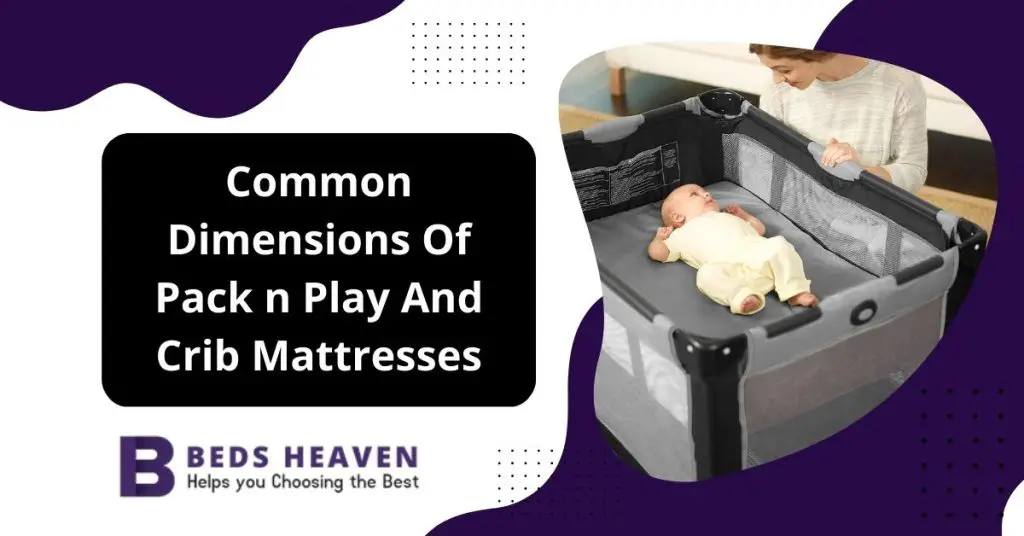
It is essential to know the dimensions of a pack ‘n play or crib mattress before making a purchase decision. The following are the common dimensions of pack-n-play and crib mattresses:
1. Pack-n-play mattresses:
In general, the most common size of a pack-n-play mattress is 38 inches long by 26 inches wide. In spite of this, there are some variations in size, and depending on the brand or model, the size may vary slightly.
2 . Crib mattresses:
The standard size of a crib mattress is 52 inches long by 28 inches wide. There may, however, be slight variations in size, so it is important to measure the crib before purchasing a mattress.
It is important to note that some pack-n-play models come with a mattress included, while others require a separate purchase. In addition, it is important to review the manufacturer’s guidelines to ensure that the mattress fits correctly and is safe for your child. Always choose the correct mattress size and follow the manufacturer’s instructions to avoid suffocation.
Factors to Consider When Determining If a Crib Mattress Can Fit In a Pack n Play
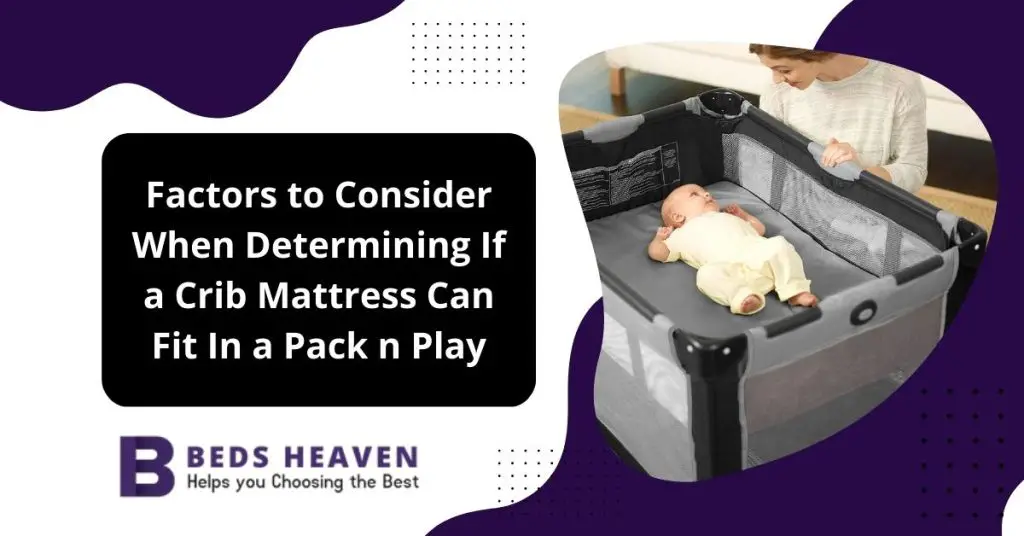
Consider the following factors before trying to fit a crib mattress into a pack-n-play:
1. Size:
Mattresses for pack-n-plays are typically smaller than those for cribs, as we mentioned earlier. To ensure that the crib mattress fits comfortably, you should measure the interior dimensions of the pack-n-play.
2. Depth:
As pack-n-play mattresses are typically thinner than crib mattresses, it is also important to consider the depth of the crib mattress. The crib mattress may not fit properly if it is too thick, resulting in a hazardous sleeping environment.
3. Shape:
The shape of pack-n-play mattresses is rectangular, whereas the shape of crib mattresses is more oval. In order to fit the pack-n-play, the crib mattress should not be too rounded or wide.
4. Safety:
The American Academy of Pediatrics (AAP) recommends using only the mattress included with the pack-n-play since it is tested for safety and durability. When using a crib mattress, make sure it fits snugly and does not create gaps that can cause suffocation.
5 . Manufacturer Guidelines:
You should always check the manufacturer’s guidelines to ensure that the pack-n-play can be used with a crib mattress. A mattress that is not recommended can pose a safety risk to your child.
6. Weight:
In general, crib mattresses are heavier than pack-n-play mattresses, which makes it more difficult to move the pack-n-play. When using a crib mattress in a pack-n-play, be sure not to exceed the weight limit of the pack-n-play.
To conclude, although it is possible to fit a crib mattress in a pack-n-play, it is essential to consider the above factors in order to ensure your child’s safety and comfort.
Safety Concerns Associated With Using a Crib Mattress In a Pack n Play
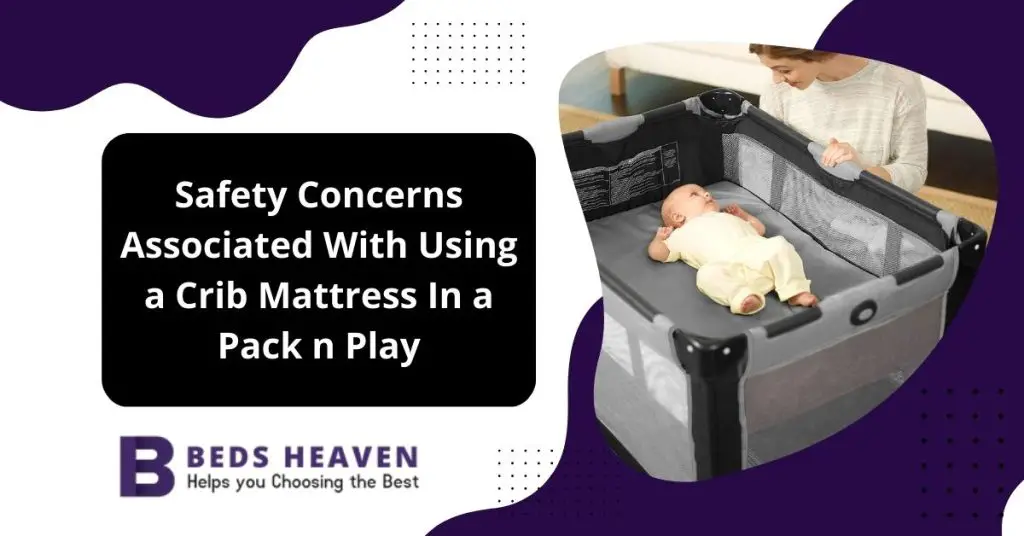
It is not recommended by most manufacturers or experts to use a crib mattress in a pack-n-play due to several safety concerns. Using a crib mattress in a pack-n-play can pose the following safety risks:
1. Suffocation:
Since crib mattresses are thicker than pack n’ play mattresses, they may not fit snugly, causing gaps that may trap your baby’s head and cause suffocation.
2. Overheating:
Various materials are used to make crib mattresses, some of which may retain more heat than pack-n-play mattresses, which can increase your baby’s discomfort and increase the risk of Sudden Infant Death Syndrome (SIDS).
3. Fit:
If the crib mattress is too small, it may move around in the pack-n-play and create gaps through which your baby may slip. On the other hand, if the crib mattress is too large, it may not fit correctly in the pack-n-play, which can cause the mattress to bend or even break the pack-n-play.
4. Movement:
Pack-n-play mattresses are generally heavier than crib mattresses, making them difficult to move around. It can also make it difficult to collapse the pack-n-play for storage or transportation.
As a result, using a crib mattress in a pack-n-play can present a number of safety concerns. To ensure your baby has a safe and comfortable sleeping environment, it is important to follow the manufacturer’s instructions and only use the mattress that comes with the pack-n-play.
Tips On How To Make a Crib Mattress Fit In a Pack n Play
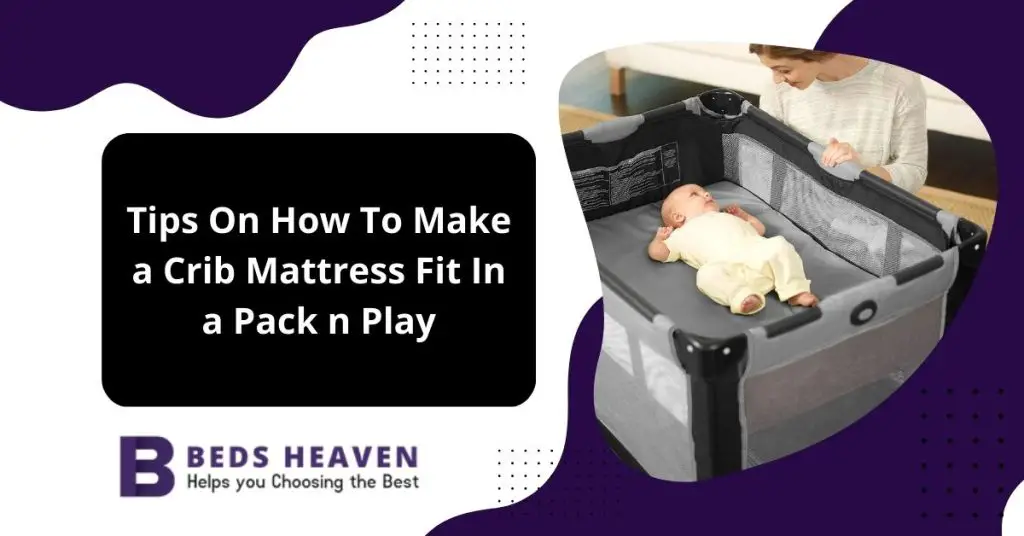
Although it is not recommended to use a crib mattress in a pack-n-play, there may be circumstances in which this is necessary. To make a crib mattress fit in a pack-n-play, follow these tips:
1. Measure the Pack n Play:
It is recommended that you measure the interior dimensions of the pack-n-play before you attempt to fit a crib mattress in it. It is important to ensure that the crib mattress fits comfortably without creating gaps that may pose a suffocation risk.
2. Choose a thin crib mattress:
Pack-n-play mattresses tend to be thinner than crib mattresses, so it is important to choose a crib mattress that is also thin. Choosing a thinner mattress will ensure that the pack-n-play will fit correctly without being bent.
3. Secure the Crib Mattress:
In order to ensure that the crib mattress fits snugly in the pack-n-play, use bungee cords or other fasteners to secure the mattress in place. You should ensure that there are no gaps between the mattress and the sides of the pack-n-play.
4. Check for Stability:
Once the crib mattress has been placed, make sure that the pack-n-play is stable and does not wobble or move. It is possible for your baby to fall from a wobbly pack-n-play.
5. Check for suffocation hazards:
The mattress should not have any gaps between it and the sides of the pack-n-play. Make sure that the mesh sides of the pack-n-play are not pushed in by the crib mattress, as this can cause a suffocation hazard.
Final Words
In summary, it’s not recommended to use a crib mattress in a pack-n-play, but the tips above can help you do it. You should always prioritize your baby’s safety so that the pack-n-play is both safe and comfortable for him.
Importance of Choosing The Right Size Mattress For Your Child’s Safety And Comfort
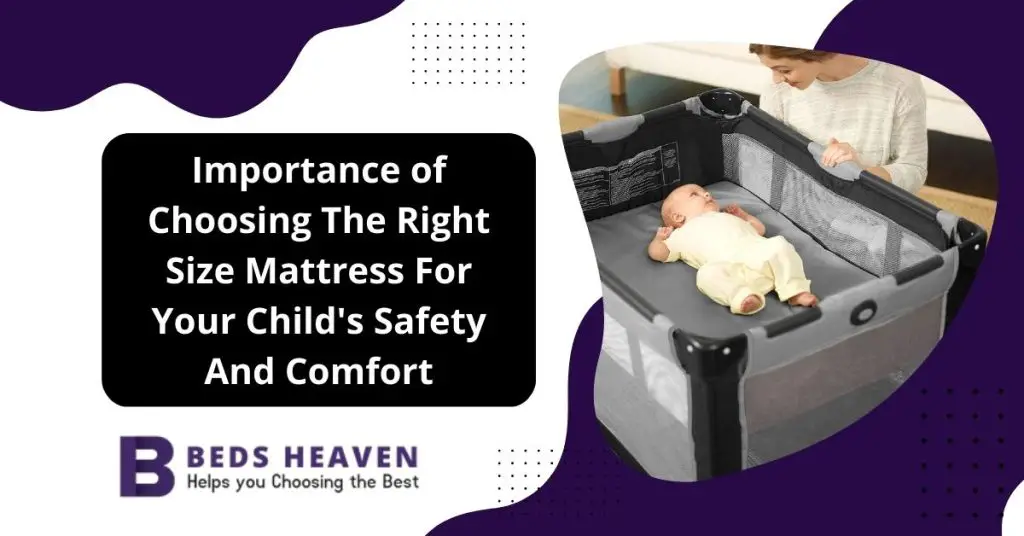
It is essential to choose the right size mattress for your child to ensure their safety and comfort. Here are a few reasons why:
1. Safety:
A mattress that is too small can allow your baby’s body to slip through gaps, while a mattress that is too large can bend and cause gaps between the mattress and the sides of the crib or pack n’ play, which can cause suffocation hazards. Mattresses that are properly sized and fit snugly in your child’s crib or pack-and-play reduce the risk of injury.
2. Comfort:
It may be difficult for your baby to get a good night’s sleep if the mattress is too small. Conversely, a too-large mattress may result in your baby waking up frequently throughout the night due to discomfort. A mattress that is the right size for your baby will provide them with optimal comfort and ensure that they are able to sleep well at night.
3. Support:
It is important that the mattress that you choose for your baby is the right size for their growing body. In particular, this is essential for infants who spend a great deal of time sleeping. By keeping your baby’s airway open, a well-supported mattress can help prevent Sudden Infant Death Syndrome (SIDS).
4. Durability:
When a mattress is too small or too large, it can suffer premature wear and tear, reducing its lifespan. It is more likely that a properly sized mattress will experience less wear and tear and will last longer.
Final words
It is important to choose the right size mattress for your child to ensure their safety, comfort, support, and durability. Ensure that the mattress fits correctly by following the manufacturer’s guidelines and measuring the crib’s or pack n’ play’s interior dimensions. The right mattress will provide your child with the optimal sleeping environment in which they will be able to grow and thrive.
FAQ’s
1. How long can a baby sleep in a Pack n-Play?
As long as the baby fits comfortably in the Pack n Play, they can sleep there. Nevertheless, once they outgrow it, you will have to transition them to a larger bed.
2. Can I use a Pack n-Play as a crib?
Yes, you can use a Pack n Play to provide a safe sleeping environment for your child. For assembly and operation, it is important to follow the instructions provided by the manufacturer.
3. Can I add extra padding or blankets to the Pack n Play mattress?
It is not recommended to add any additional padding or blankets to the Pack n Play mattress. Your baby may be exposed to an unsafe sleeping environment as a result.
4. Can I purchase a replacement mattress for my Pack n Play?
It is possible to purchase a replacement mattress designed specifically for your Pack n Play.
5. Can a crib mattress fit in a Pack n-Play?
It is not possible to use a crib mattress in a Pack n-Play.
Conclusion
In Conclusion, using the right mattress for your child is necessary for their safety, comfort, and overall health. The dimensions of pack-n-play and crib mattresses are similar, but they differ in their features and designs, making them suitable for different uses. While crib mattresses are thicker, heavier, and designed for long-term use in a stationary crib, pack-n-play mattresses are thinner, lighter, and portable.
It is important to select the right size mattress for your pack-n-play or crib in accordance with the manufacturer’s instructions. A mattress that is too large or too small may cause gaps, reduce support, and increase the risk of suffocation and injury. It is not recommended to use a crib mattress in a pack-n-play unless it is unavoidable, and only if it is fitted correctly and secured in place to minimize potential hazards.

